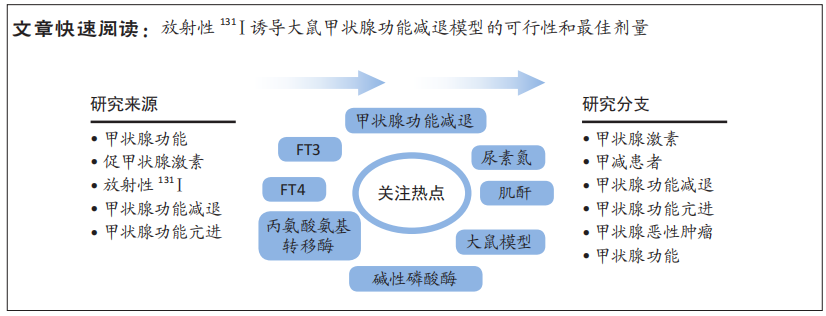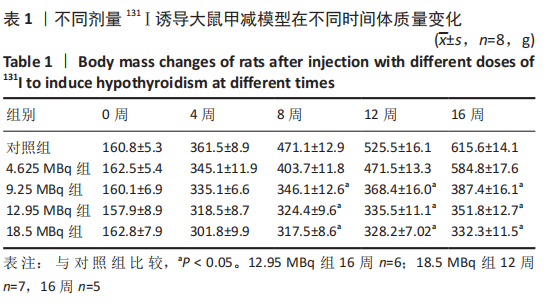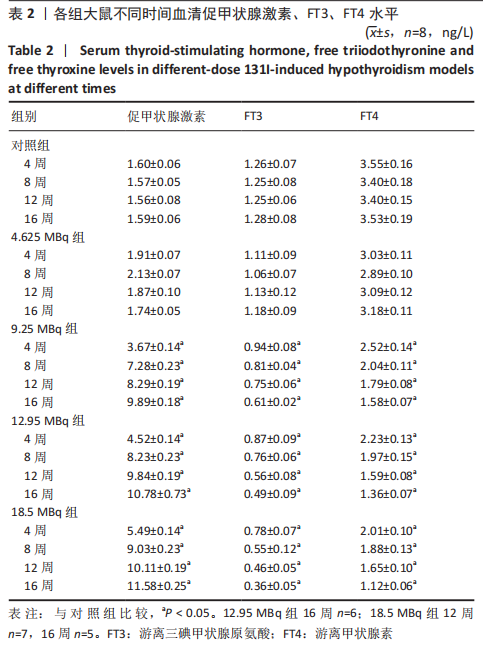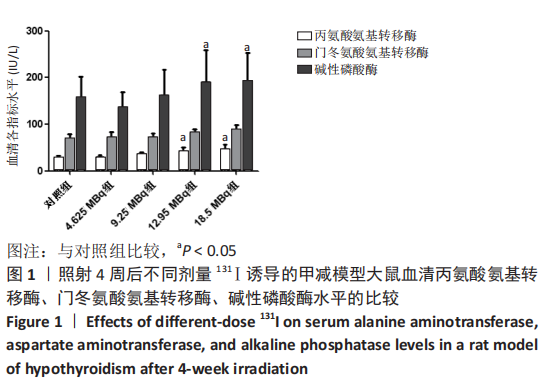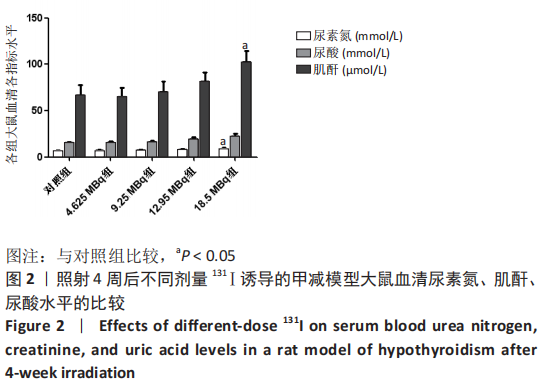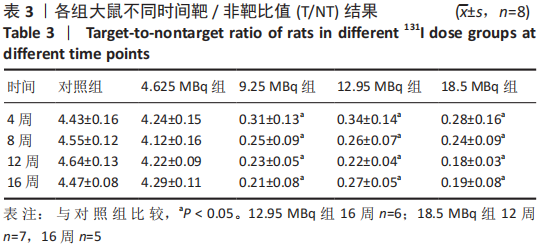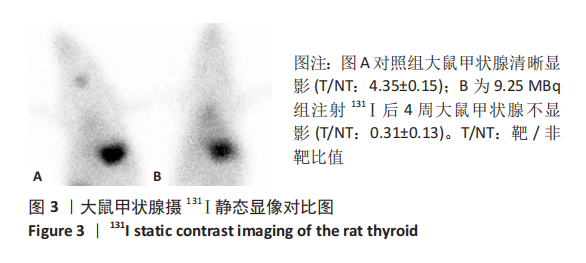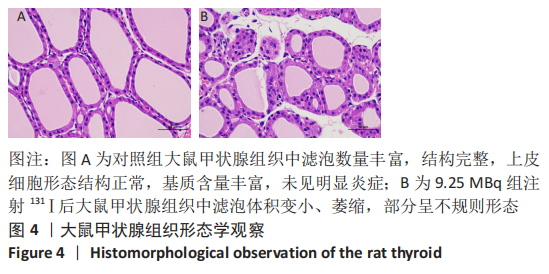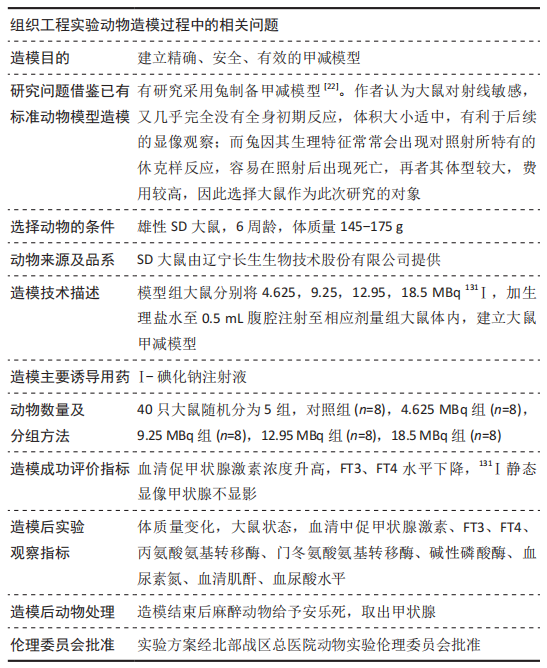[1] KU A, FACCA VJ, CAI Z, et al. Auger electrons for cancer therapy - a review. EJNMMI Radiopharm Chem. 2019;4(1):27.
[2] JØDAL L. Beta emitters and radiation protection. Acta Oncol. 2009;48(2): 308-313.
[3] HWANG JH, JUNG HW, KANG SY, et al. Therapeutic effects of acupuncture with MOK, a polyherbal medicine, on PTU-induced hypothyroidism in rats. Exp Ther Med. 2018;16(1):310-320.
[4] CHIOVATO L, MAGRI F, CARLÉ A. Hypothyroidism in Context: Where We’ve Been and Where We’re Going. Adv Ther. 2019;36(Suppl 2):47-58.
[5] CHAKER L, BIANCO AC, JONKLAAS J, et al. Hypothyroidism. Lancet. 2017; 390(10101):1550-1562.
[6] 白庆双,吴彩兰,谭建.胺碘酮相关甲状腺疾病的诊断与治疗研究进展[J].山东医药,2021,61(32):101-104.
[7] 王婵,侯彦杰,杨烨,等.头颈部肿瘤放射性甲状腺功能减退的研究现状[J].中华放射医学与防护杂志,2021,41(11):867-873.
[8] RODRIGUEZ-GUTIERREZ R, MARAKA S, OSPINA NS, et al.Levothyroxine overuse: time for an about face? Lancet Diabetes Endocrinol. 2017;5(4): 246-248.
[9] WILSON SA, STEM LA, BRUEHLMAN RD. Hypothyroidism: Diagnosis and Treatment. Am Fam Physician. 2021;103(10):605-613.
[10] CALISSENDORFF J, FALHAMMAR H. To Treat or Not to Treat Subclinical Hypothyroidism, What Is the Evidence? Medicina (Kaunas). 2020;56(1):40.
[11] PETERSON SJ, CAPPOLA AR, CASTRO MR, et al. An Online Survey of Hypothyroid Patients Demonstrates Prominent Dissatisfaction. Thyroid. 2018;28(6):707-721.
[12] MCANINCH EA, BIANCO AC. The Swinging Pendulum in Treatment for Hypothyroidism: From (and Toward?) Combination Therapy. Front Endocrinol (Lausanne). 2019;10:446.
[13] MATEO RCI, HENNESSEY JV. Thyroxine and treatment of hypothyroidism: seven decades of experience. Endocrine. 2019;66(1):10-17.
[14] TAYLOR PN, ALBRECHT D, SCHOLZ A, et al. Global epidemiology of hyperthyroidism and hypothyroidism. Nat Rev Endocrinol. 2018;14(5):301-316.
[15] AKIROV A, FAZELZAD R, EZZAT S, et al. A Systematic Review and Meta-Analysis of Patient Preferences for Combination Thyroid Hormone Treatment for Hypothyroidism. Front Endocrinol (Lausanne). 2019;10:477.
[16] PLANCK T, LANTZ M, PERROS P, et al. Use of Thyroid Hormones in Hypothyroid and Euthyroid Patients: A 2020 THESIS Questionnaire Survey of Members of the Swedish Endocrine Society. Front Endocrinol (Lausanne). 2021;12:795111.
[17] IDREES T, PALMER S, MACIEL RMB, et al. Liothyronine and Desiccated Thyroid Extract in the Treatment of Hypothyroidism. Thyroid. 2020;30(10): 1399-1413.
[18] DA CONCEIÇÃO RR, FERNANDES GW, FONSECA TL, et al. Metal Coordinated Poly-Zinc-Liothyronine Provides Stable Circulating Triiodothyronine Levels in Hypothyroid Rats. Thyroid. 2018;28(11):1425-1433.
[19] AFARINESH MR, SHAFIEI F, SABZALIZADEH M, et al. Effect of mild and chronic neonatal hypothyroidism on sensory information processing in a rodent model: A behavioral and electrophysiological study. Brain Res Bull. 2020;155:29-36.
[20] KAYES TD, WEISMAN GA, CAMDEN JM, et al. New Murine Model of Early Onset Autoimmune Thyroid Disease/Hypothyroidism and Autoimmune Exocrinopathy of the Salivary Gland. J Immunol. 2016;197(6):2119-2130.
[21] Sefati N, Abbaszadeh HA, Fadaei Fathabady F, et al. The Combined Effects of Mesenchymal Stem Cell Conditioned Media and Low-Level Laser on Stereological and Biomechanical Parameter in Hypothyroidism Rat Model. J Lasers Med Sci. 2018;9(4):243-248.
[22] 张豪云, 巩涛, 宁殿宾,等. 兔甲状腺近全切除术+131Ⅰ清甲的甲状腺功能减退模型建立[J]. 临床外科杂志,2013,21(10):765-767.
[23] TIAN L, SHAO F, QIN Y, et al. Hypothyroidism and related diseases: a methodological quality assessment of meta-analysis. BMJ Open. 2019;9(3): e024111.
[24] NIEDOWICZ DM, WANG WX, PRICE DA, et al. Modulating Thyroid Hormone Levels in Adult Mice: Impact on Behavior and Compensatory Brain Changes. J Thyroid Res. 2021;2021:9960188.
[25] SUN J, HUI C, XIA T, et al. Effect of hypothyroidism on the hypothalamic-pituitary-ovarian axis and reproductive function of pregnant rats. BMC Endocr Disord. 2018;18(1):30.
[26] GŁOMBIK K, DETKA J, BUDZISZEWSKA B. Venlafaxine and L-Thyroxine Treatment Combination: Impact on Metabolic and Synaptic Plasticity Changes in an Animal Model of Coexisting Depression and Hypothyroidism. Cells. 2021;10(6):1394.
[27] BEHESHTI F, HOSSEINI M, SHAFEI MN. The effects of Nigella sativa extract on hypothyroidism-associated learning and memory impairment during neonatal and juvenile growth in rats. Nutr Neurosci. 2017;20(1):49-59.
[28] HOSSEINI M, DASTGHAIB SS, RAFATPANAH H, et al. Nitric oxide contributes to learning and memory deficits observed in hypothyroid rats during neonatal and juvenile growth. Clinics (Sao Paulo). 2010;65(11):1175-1181.
[29] 贾锡莲,曲竹秋,徐灿坤,等.右归丸对实验性甲减大鼠甲状腺滤泡细胞凋亡相关因子Bcl-2/Bax表达的影响[J].山东中医杂志,2007,26(10): 706-708.
[30] MOON JH, KIM HJ, KIM HM, et al. Decreased expression of hepatic low-density lipoprotein receptor-related protein 1 in hypothyroidism: a novel mechanism of atherogenic dyslipidemia in hypothyroidism. Thyroid. 2013; 23(9):1057-1065.
[31] KEMKEM Y, NASTESKA D, DE BRAY A, et al. Maternal hypothyroidism in mice influences glucose metabolism in adult offspring. Diabetologia. 2020; 63(9):1822-1835.
[32] ENGIN AB, SEPICI-DINCEL A, GONUL II, et al. Oxidative stressinduced endothelial cell damage in thyroidectomized rat. ExpToxicol Pathol.2012; 64(5):481-485.
[33] 蔡亚囡,蔡欣蕊,钱秋海,等.甲荣康对甲状腺功能减退模型大鼠卵巢组织EGFR表达的影响[J].西部中医药,2019,32(11):4-7.
[34] SAMADI R, GHANBARI M, SHAFIEI B, et al. High dose of radioactive iodine per se has no effect on glucose metabolism in thyroidectomized rats. Endocrine. 2017;56(2):399-407.
[35] BAJWA SJ, SEHGAL V.Anesthesia and thyroid surgery: The never ending challenges. Indian J Endocrinol Metab. 2013;17(2):228-234.
[36] LIM YS, KIM HB, PARK JH, et al. Effects of excessive fibrin deposit and polylactide adhesion barrier on wound healing in thyroidectomy murine wound model. Head Neck. 2018;40(6):1207-1213.
[37] BANJI D, BANJI OJ, PRATUSHA NG, et al. Investigation on the role of Spirulina platensis in ameliorating behavioural changes, thyroid dysfunction and oxidative stress in offspring of pregnant rats exposed to fluoride. Food Chem. 2013;140(1-2):321-331.
[38] YANG H, XING R, LIU S, et al. Analysis of the protective effects of γ-aminobutyric acid during fluoride-induced hypothyroidism in male Kunming mice. Pharm Biol. 2019;57(1):29-37.
[39] WILMAR M. Wiersinga. Graves’ Disease: Can It Be Cured?. Endocrinol Metab (Seoul). 2019;34(1): 29-38.
[40] 蒋宁一,陈贵兵,刘雄英,等.131Ⅰ 致兔甲状腺功能低下模型制作的探讨[J].现代临床医学生物工程学杂志,2005,11(6):463-466,472.
[41] ATKINS F, VAN NOSTRAND D, MOREAU S, et al. Validation of a Simple Thyroid Cancer Dosimetry Model Based on the Fractional Whole-Body Retention at 48 Hours Post-Administration of (131)I. Thyroid. 2015;25(12):1347-1350.
[42] YLLI D, KLUBO-GWIEZDZINSKA J, WARTOFSKY L. Thyroid emergencies. Pol Arch Intern Med. 2019;129(7-8):526-534.
[43] UDOVCIC M, PENA RH, PATHAM B, et al. Hypothyroidism and the Heart. Methodist Debakey Cardiovasc J. 2017;13(2):55-59.
[44] YLLI D, KLUBO-GWIEZDZINSKA J, WARTOFSKY L. Thyroid emergencies. Pol Arch Intern Med. 2019;129(7-8):526-534.
[45] YU D, ZHOU H, YANG Y, et al. The bidirectional effects of hypothyroidism and hyperthyroidism on anxiety- and depression-like behaviors in rats. Horm Behav. 2015;69:106-115.
[46] LARSSON M, RUDQVIST N, SPETZ J, et al. Long-term transcriptomic and proteomic effects in Sprague Dawley rat thyroid and plasma after internal low dose 131I exposure. PLoS One. 2020;15(12):e0244098.
[47] RIZZO LFL, MANA DL. Treatment of hypothyroidism in special situations. Medicina (B Aires). 2020;80 Suppl 6:83-93.
[48] R P, M J, A H, et al. Evaluations for Determination of Optimum Shields in Nuclear Medicine. J Biomed Phys Eng. 2020;10(5):651-658.
[49] RUDQVIST N, SPETZ J, SCHÜLER E, et al. Transcriptional response to 131I exposure of rat thyroid gland. PLoS One. 2017;12(2):e0171797.
[50] LARSSON M, RUDQVIST NP, SPETZ J, et al. Age-related long-term response in rat thyroid tissue and plasma after internal low dose exposure to 131I. Sci Rep. 2022;12(1):2107.
[51] 陈宇彤,李晨晨,刘阳,等.急性放射性皮肤损伤Wistar大鼠模型的建立[J].中国组织工程研究,2021,25(2):237-241.
[52] 敬华,李丹,陈义光,等.化学发光免疫分析、放免分析和磁珠酶免疫分析测定血清甲状腺激素的评价[J].标记免疫分析与临床,2005,12(1):38-40.
[53] SZONYI G, BOWERS P, ALLWRIGHT S, et al. A comparative study of 99mTc and 131I in thyroid scanning. Eur J Nucl Med. 1982;7(10):444-446.
[54] GÓROWSKI T, CHOMICKI OA. Some comparative studies using 99mTc and 131I in thyroid scanning. Nuklearmedizin. 1976;15(6):268-272.
|
